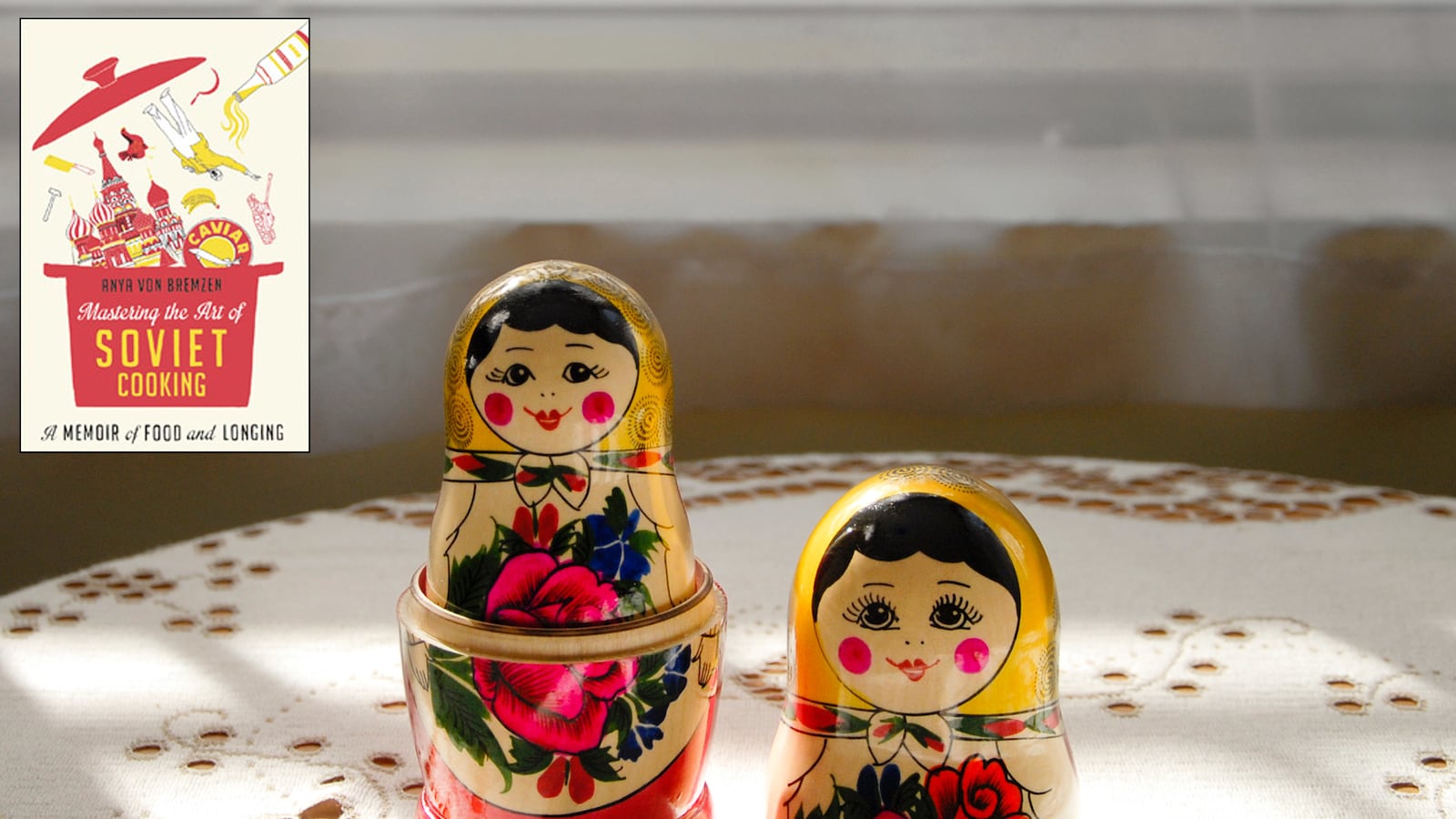One of the most misleading phrases in the Russian language is “Ochen’ vkusno!” which is invariably said any time you sit down to a meal in Russia that a hostess has gone to some effort to prepare. It means “very tasty;” and it simply never is—that is, not to those unaccustomed to the flavors of the Slavic palate. Reading Anya von Bremzen’s one-of-a-kind culinary and sociopolitical memoir, Mastering the Art of Soviet Cooking, a nostalgically anti-nostalgic tribute to 20th century life and food in the land once known as the Soviet Union, I thought of that gustatory paradox. Although I’m American, devoid of any jot of Russian blood, an accident of birth assured that taste memories of borscht, poppy-seed cake, and the soft, meat-filled buns called pirozhki romp through my psyche. From my tenderest youth, my slavophile professor parents threw raucous Russian Club parties at our home for their students, for which my mother spent hours cranking beef and softened onions through a meat grinder she’d lugged back from a Moscow study trip. My Cold War childhood was like an unending session of Soviet show-and-tell. But when my school friends would drop by our kitchen and catch the whiff of dill, they would flee. Visiting Moscow for the first time in the 1990s, I belatedly understood my friends’ reaction, when I confronted unfamiliar Russian treats that made my flesh crawl. I remember in particular a clearish, jiggling aspic—big and flat as a sheet cake—that contained a pale poached fish the size of a man’s foot, served to me by an eminent aproned professor in a Moscow high-rise in 1993. She had spent days scouring the markets for the ingredients. Trying not to breathe, I swallowed a couple of mouthfuls—I remember an impression of Knox Blox made of wallpaper paste—smiled faintly, and said as convincingly as I could, “Ochen’ vkusno!”

Luckily, Anya von Bremzen not only is familiar with the full gamut of Slavic fare, she retains affection from her Soviet childhood for alarming fish entrées accompanied by “enticing whiffs of wallpaper glue.” More luckily still, through breathtaking feats of raconteurial skill, she makes you envy the recipes that make her mouth water, even when you don’t yourself hanker for the mythic meals she conjures—and even when she herself admits that she’d never eaten them, given the endless defitsits (food shortages) of her native land. In Mastering the Art of Soviet Cooking, she calls up visions of the “skatert’ samobranka” —the magical self-filling tablecloth of Russian folklore—which tormented hungry Soviets with dreams of juicy sausages, herring-under-fur-coat (pickled herring mixed with chopped potatoes and carrots, topped with shredded beets, slathered in slippery sauce), kulebiaka pastries stuffed with salmon, dried sturgeon spine and mushrooms; jellied ham rolls, and, everywhere, glistening garlands of mayonnaise (the Soviet-era “Provensal” mayonnaise brand, “loose” and “tangy-sharp”) which is to Muscovites what madeleines were to Proust.
In 1974, when the author was 11, she and her mother, Larisa Naumovna Frumkina, left the Soviet Union and moved to America, trading Moscow’s empty store shelves for the sterile cornucopia of a Philadelphia Pathmark. The ease of getting groceries in America elated the mother, but demoralized the daughter: “What happened when you replaced the heroic Soviet verb dostat’ (to obtain with difficulty) with the banal kupit’ (to buy), a term barely used back in the USSR?” von Bremzen asks. In her opinion, “Shopping at Pathmark was acquisitioning robbed of thrills, drama, ritual.” But her mother disagreed. Although she was the daughter of a Soviet war hero and the wife of a man who had the über-Socialist job of monitoring the color of Lenin’s embalmed body, Frumkina had no love for the lines she left behind. All the same, even she could not resist bringing one memento to the New World: the lavishly illustrated Soviet culinary bible The Book of Tasty and Healthy Food. This book—the kniga, von Bremzen calls it, was devised by Stalin’s crafty Armenian food commissar Anastas Mikoyan (think of him as the Soviet Milo Minderbinder), and went through multiple permutations over the years, each edition a barometer of the country’s shifting ideological climate.
In 2011, in a kitchen in Queens, by now a much-lauded food and travel writer, von Bremzen embarked on the project of creating distinct totemic meals to capture the mood of each decade of the 20th century in her native land. Kniga in hand, she enlisted her now septuagenarian mother as sous-chef—so what if neither of them had ever eaten the food they were about to prepare, much less cooked it? “Neither I nor Mom had a clue how they were meant to taste,” she admits. While whipping up her first chapter and their first feast—an homage to the dining excesses of the czars—she found herself pulling an all-nighter during a blazing New York heat wave to make Guriev kasha—a heavy porridge studded with homemade candied nuts, berries, and multiple layers of scorched-cream skins called penki. She writes, “Chained to the oven door, drenched in sweat, I was ready to assault palaces, smash Fabergé eggs. I cursed the Romanovs! I cheered the Russian Revolution!”
Mastering the Art of Soviet Cooking is not only a magic tablecloth, it’s a magic carpet that revisits the roads and lanes of the former Soyuz, surveying the tales of hardship and hardwon joys of von Bremzen’s relatives and the Russian people. A chapter on the 1930s shows the author’s toddler mother celebrating Election Day in Leningrad with her family. As champagne corks pop and Communist throngs sing, “O vast is my country!”, Stalin’s secret police buzz at the door and haul their neighbors off into the Great Terror. A watchful babushka quickly herds the children onto a balcony so they don’t miss Great Comrade Stalin’s fireworks: “Green! Red! Blue! –blooming in the sky like giant, sparkling, jubilant bouquets.” The ’30s saw the rise of Stalin’s chef, whom he sent to America to hunt down vkusnye recipes for the Soviet masses. Mikoyan brought back Yankee hamburgers and converted them to Soviet kotleti—minced patties of meat or vegetable, breaded and “fried up to a wicked crunch” that were to fill Russian stomachs ever after—at least, in prosperous times.
Von Bremzen gives the recipe for kotleti in her addendum; but she gives no recipe for the 1940s, the decade that saw the catastrophic Siege of Leningrad, during which 7-year-old Frumkina once lost a whole month of food-ration cards. When the little girl piled the coupons on a bakery counter, starving grownups snatched them: “Fingers swarming the counter like tentacles—gnarled, blackened digits; gaunt fingers with white anemic nails; red swollen fingers.” By the 50s, though, bread, potatoes, and Provensal mayo had returned to Soviet shelves, even if everyone had to stand in line for it. “Your average homo sovieticus spent a third to half of his nonworking time queuing for something,” von Bremzen writes. By the time of Putin’s accession, in 2000, the lines had thinned: there was now enough food for everybody; that is, everybody who could afford it.
In Moscow in 2011, where she had traveled to shoot a cooking show on newly hip Soviet cuisine, assisted by an ex-Kremlin chef named Viktor Belyaev, von Bremzen found herself gawping at an elaborate feast Belyaev had resurrected, “a Technicolor fantasia out of The Book of Tasty and Healthy Food—Politburo dreambook edition.’” Chatting with Belyaev during the taping, she learned that, “pre-Kremlin,” he had been a cook at Praga, the famous restaurant in Moscow’s quaint Arbat neighborhood where von Bremzen and her family had once lived. Going to Praga to pick up doughy Brezhnev-era kulebiakas and rich layered cream cakes in white paper boxes had been a cherished childhood rite. In Putin’s Moscow, she learned, Praga had gone on the block, “to be converted, no doubt, into a post-bling elite playground.” Seeing scaffolding surround this monument to her Soviet youth, she writes, “I felt as if some dear old grandparent had died.” To von Bremzen’s confusion, young Russian TV producers, eavesdropping on her reminiscences, “lapped up my socialist misadventures.” She asked them, “But isn’t Moscow full of people who remember the USSR a lot better than I do? I mean, “I’m from New York!” A crew member explained, “Here we have mishmash for our memory. But an émigré like you—you remember things clearly.”
Von Bremzen remembers, but she also researches. After reading her account of the origins of the fish-in-aspic that had spooked me in Moscow in the ’90s, I longed to try it again, my appetite whetted by the spice of history. This delicacy, she explains, was born in the era of the czars, reviled as a damnable bourgeois relic after Lenin’s rise, then rehabilitated by Stalin as a form of gustatory patriotism. The Soviet dishes he exalted were not mere sustenance, they were “shining political symbols, furthering the illusion that czarist indulgences were now accessible to the masses.” Of course, these indulgences were never widely accessible; not in the age of the czars; not under Stalin, not under Brezhnev, not under Yeltsin, and not now, under Putin, for the “shallow-pocketed.” But the struggle to attain them has always been open to all; and in Mastering the Art of Soviet Cooking, Anya von Bremzen lets Russians and non-Russians alike savor the aroma of illusory empire—eternal, indestructible, and in the imagining, ochen’ vkusno.






